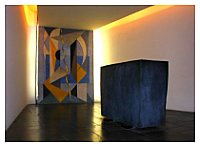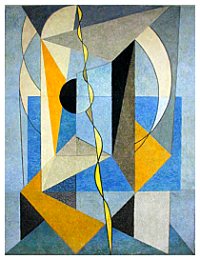Unwrapping her gauzy veils a "White Madonna" danced on the podium. She symbolized "Christianity" or the "Mother of the World encompassing forms of the creative feminine spirit which has unfolded over the centuries from Egypt, Babylonia, China and Europe," said a program distribute at the Temple of Understanding's benefit dinner.
The dinner, held Oct. 12 at the Waldorf Astoria, featured this dramatic skit on "Christianity" and five other skits on the major faiths to commemorative $5,000,000 Temple to be built on 50 acres by the Potomac River, Washington, D. C.
The Temple brochure describes the edifice as a "Spiritual United Nations" designed to fulfill the rituals of the six major faiths and replace "nationalist limitations" with "universal understanding" for "citizens of the world!"
PUBLICISTS for this tax-exempt "Project Understanding" claim support from the "pennies donated by hairdressers, taxicab drivers and workers all over the world." But judging from the Temple's printed list of sponsors it can count on more influential backing.
For instance:
John D. Rockefeller IV
Socialist leader Norman Thomas
Rt. Rev. James A. Pike of San Francisco
Cary Grant
Defense Secretary Robert S. McNamara, a founding member of the Fund for the Republic's Center for Democratic Institutions
Militant pacifist and Nobel Peace Prize and Nobel Peace Prize winner Philip Noel Baker
Holland D. Roberts of the Academic Freedom Committee, a former head of the Communist party's California Labor School who was identified as a "party member" at a Jan. 22, 1956 hearing of the Subversive Activities Control Board
U. Alexis Johnson, depute undersecretary of state for political affairs
Sen. Kenneth B. Keating (R-N.Y.), Prof. Pitirim A. Sorokin, director of Harvard University's Research Center for Creative Altruism and Brooks Hays, special assistant to President Kennedy
AT THE WALDORF'S Starlight Roof I heard Mrs. Dickerman Hollister, president of the Temple of Understanding (P.O. Box 191, Greenwich, Conn.), address some 500 UN delegates and socialites. In a voice choked with fervor, she said:
“We are sending an idea to create a global symbol of the world.”
Then she struck with a wand an egg held aloft by a child. Out popped a "magic" golden tree with six branches on either side.
THE SYMBOLISM is not surprising in view of the mystic appeal of the internationalist dream. For example, one of the Temple sponsors is Roland Gammond, former director of the Laymen's Movement, World Parliament of Religions. This international, non-sectarian group of big businessmen, psychiatrists and other professional men meet in the seclusion of Wainwright House, Milton Point, Rye, N. Y., to study scientific mind control.
I secured the texts of some of the Wainwright House seminars which treat of such topics as "clairvoyance," "automatic writing," "hallucinations," "religion as part of an enlarged science" and "the psychic content of the alchemical symbols."
According to this year's Sept.-Oct. issue of the Laymen's Review published at Wainwright House, the Movement "spearheaded" the establishment of the UN Meditations Room which happens to contain some of those "alchemical symbols."
THE UN MEDITATION Room mural is divided into 72 separate sections—the tetragrammaton or Divine Name of 72 words. It depicts triangles and pyramids representing "the deity" in accordance with the ancient Babylonian symbols. Also a part of this mural is a spiral figure intertwined with a diagonal line which may represent Hermes' wand, the Cadeuces, traditional symbol of the sex forces or Kundalini.
The mural's center sphere and outer circle roughly form an eye. The "all seeing eye" of the deity theme is to be repeated in the Temple building by a glass eye faceted like a diamond to reflect the rays of the sun through the six wings.
IT IS INTERESTING to note that the Interparliamentary Union — Temple of Understanding sponsor Sen. Keating is IPU secretary — adopted a few weeks ago as its emblem:
"A Temple of Law with six columns for the six continents to show the Universality of the Union."
The IPU, which has been financed in part by the tax-exempt Carnegie Endowment for International Peace, consists of a training corps of legislators who meet regularly with their Communist "counterparts" to set up a world parliamentary government. While some people may dismiss these humanistic temples as another example of "goofy" internationalism, apologists for Moscow view them as a serious component in their drive to promote the "Social Gospel."
Two temple sponsors are included in the Senate Internal Security's "list of the most typical sponsors of front organizations" published April 23, 1956.
They are:
-
Jerome Davis, New Haven, Conn., educator who heads Promoting Enduring Peace, a group whose literature whose literature is distributed by the Arcane School (operated by the tax-exempt "non-political" Lucis Trust on the 32nd and 33rd floors of 11 W. 42nd St., N. Y.) The international Lucis Trust network, which has substantial financial backing, regularly holds "Full Moon Meditation Meetings" at the Carnegie Endowment for International Peace to promote UNESCO and the "New World Religion."
-
Prof. Kirtley Mather of the Geologic Museum, Cambridge, Mass., who has served on a four-man panel evaluating "physical research" at Wainwright House.
-
ANOTHER TEMPLE backer is Rev. Lee H. Ball, executive secretary of the Methodist Federation for Social Action, an organization cited as a front by the Senate Internal Security Subcommittee on April 23, 1956.
On July 7, 1953, Ben Gitlow, former secretary of the Communist party, testified under oath that Ball was one of "the principle individuals involved in the Communist conspiracy to subvert the church for Communist purposes."
Shouldn't they add the hammer and sickle symbol to the second "Meditation Room" slated for the new Washington Temple?
|
from UN Website
Meditation Room, An example of his interest is reflected in this exchange of correspondence in Swedish regarding the design of the fabric to be used for the carpeting. The letter by Dag Hammarskjöld is translated.
In addition, an abstract mural, a composition of interlocking geometric patterns which is supposed to evoke a feeling of the essential oneness of God, was ordered by Dag Hammarskjöld from his artist friend Bo Beskow.
|
by Edith Kermit Roosevelt
The New Hampshire Sunday Times News
October 21, 1962


"herve leger dresses"
ReplyDelete"coach outlet clearance"
"mulberry uk"
"air max 90"
"longchamp solde"
"swarovski crystal"
"true religion jeans"
"coach outlet"
"hermes belt for sale"
"marc jacobs"
"cheap mlb jerseys"
"chaussure louboutin"
"swarovski outlet"
"oakley sunglasses"
"coach outlet"
"coach handbags"
"timberland shoes"
"iphone case uk"
"coach outlet store"
"ferragamo outlet"
"louis vuitton handbags outlet"
"christian louboutin outlet"
"ralph lauren uk"
"louis vuitton handbags outlet"
"ed hardy clothing"
"ray-ban sunglasses"
"oakley sunglasses wholesale"
"ray ban sunglasses"
"rolex watches"
"fred perry polo shirts"
"ralph lauren pas cher"
"rolex watches"
"rolex watches for sale"
"cazal outlet"
"tiffany outlet"
16.7.13qqqqqing
futbol baratas
ReplyDeletelululemon outlet
north face outlet
canada goose jackets
michael kors outlet
nike outlet
oakley sunglasses
cheap jordans free shipping
the north face jackets
chaussure louboutin
chanyuan11.23
Bunny Easter Cute HD Pics Bunny Easter Cute HD Pictures
ReplyDeleteEaster Bunny Pictures Images For Desktop, PC, Laptops
happy easter day
Easter Coloring Pages
happy Good Friday 2017
LiveMNC is one of the best cheap web hosting services provider company in India.
ReplyDeleteWe Craft Stunning Websites, App and Digital Marketing.
Cheap web hosting services in India
Best Website Designing and Development services in India
worldwise Affordable & Effective professional Digital Marketing services company
Local professional affordable Website Designing & Development services
company worldwise
Call: + 91-9461234545 |(Multi-channel)(LiveMNC.com)
Refrigerator Repair in Jaipur
ReplyDeleteWater Cooler repair in Jaipur
Washing Machine Repair in Jaipur
washing machine service in Jaipur
visit here
ReplyDeletebest wifi camera
mirror camera
camera
official website
great post thanks for sharing this wonderful post
ReplyDeletetutuapp apk
tutuapp latest version
tutuapp for ios
tutuapp alternative
tutuapp for mac
tutuapp download
tutuapp for iphone
tutu helper
tutuapp
tutuapp for android
tutuapp web
tutuapp for blackberry
tutuapp for pc
tutuapp mod apk
tutuapp windows
tutu helper free
best tutuapp alternative
tutuapp apk download
tutuapp for pc
tutuapp for ios
tutuapp for ios 11
tutuapp for android
tutuapp alternative
tutuapp vip
tutu helper
tutu helper vip
http://just-another-inside-job.blogspot.com/2004/05/temple-of-understanding.html
ReplyDeletewhaat a lovely post
ReplyDeleteCan You Buy A Gun Online